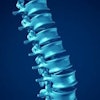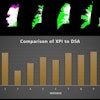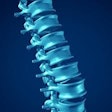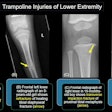Researchers in Belgium used a digital amorphous-silicon flat-panel detector for routine chest radiography, enabling them to reduce patient radiation dose by three-fourths while still producing clinically acceptable images. Dr. Peter Smeets from Ghent University shared the results of his group’s study at the 2002 American Roentgen Ray Society (ARRS) meeting in Atlanta last month.
For the study, 200 patients were examined on either the Thorax FD digital flat-panel upright system (Siemens Medical Solutions, Erlangen, Germany) or on a conventional film-screen system (Thoramat, Siemens). The mean body mass index (BMI) of the patients was 24.4 for the 100 people imaged with the digital system, and 24.1 for those 100 who underwent conventional chest x-ray.
The flat-panel system featured an amorphous-silicon array with a 43 x 43 cm, 3K x 3K detector surface; 14-bit dynamic range; and a 143-micron pixel pitch. The exposure specifications were 125 kV and 180 cm screen-focus distance on the flat-panel system, and the system's automatic exposure control was adjusted to a speed of 400.
"Our conclusion was that the digital 400 setting was at least equal, and actually better, than the 200 system for conventional imaging," Smeets said.
The digital images were transferred to a PACS using Sienet MagicView software (Siemens) and displayed on a 1K monitor. Using the European Quality Criteria for Chest Radiography, the images were evaluated by five radiologists.
For measuring entrance skin dose (ESD), every patient was fitted with 24 thermoluminescent dosimeters (TLD-100, OptoScience, Tokyo, Japan) on the back and right flank. No additional filters were used. Posterioanterior (PA) and lateral radiographs were obtained, Smeets said.
According to the results, the doses were lower for the flat-panel system than the conventional system in both views. For the PA, the ESD was 66.8 µGy versus 199.0 µGy. For the lateral view, the skin dose was 346.7 µGy for the flat-panel system and 1,286 µGy on the Thoramat unit.
Overall, the group reported a 3.34-fold reduction in radiation exposure. They also found that lowering the radiation dose had no detrimental affect on image quality.
The flat-panel system currently has two drawbacks: It is expensive and it cannot be used for fluoroscopy, Smeets said. Once flat-panel detectors become more economical, they’ll be particularly important for pediatric imaging, he added.
Other studies have come to the same conclusions as the Belgian group. Radiologists from the University of Heidelberg in Germany also did a comparison of radiation dose and image quality between conventional x-ray and a large-area flat-panel digital radiography system.
"Dose measurements with a chest phantom showed a dose reduction of approximately 50% with the digital radiography system compared with the film-screen radiography system. The image quality and the visibility of all but one anatomic structure of the images obtained with the digital flat-panel detector system were rated significantly superior," they wrote (AJR, February 2002, Vol,178:2, pp. 481-486).
A second German group from the University Hospital in Regensburg also reported a 33% dose reduction using a flat-panel detector, without loss of image quality (AJR, January 2002, Vol.178:1, pp.169-171).
By Shalmali PalAuntMinnie.com staff writer
May 27, 2002
Related Reading
The digital radiography market: From revolution to slow evolution, March 19, 2002
LCD just as good as conventional monitors for chest CR, April 30, 2002
Flat-panel combo provides less noise, lower dose, November 29, 2001
Digital radiography trumps film screen in chest imaging, November 27, 2001
Copyright © 2002 AuntMinnie.com



















